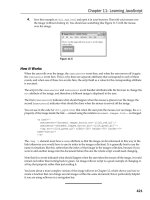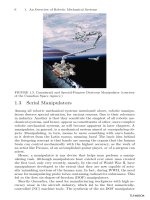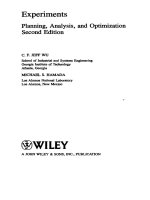Experiments Planning, Analysis, and Optimization Second Edition pdf
Bạn đang xem bản rút gọn của tài liệu. Xem và tải ngay bản đầy đủ của tài liệu tại đây (11.43 MB, 743 trang )
Experiments
Planning, Analysis, and Optimization
Second Edition
C.
F.
JEFFWU
School
of
IndustriaJ
and
Systems
Engineering
Georgia
Institute of
Technology
Atlanta,
Georgia
MICHAEL
S.
HAMADA
Los
Alamos
NationaJ
Laboratory
Los
Alamos,
New
Mexico
~WILEY
A
JOHN
WILEY
&
SONS,
INC.,
PUBLICATION
Copyright © 2009
by
John Wiley & Sons, Inc. All rights reserved.
Published
by
John Wiley & Sons, Inc. Hoboken, New Jersey
Published simultaneously in Canada
No part
of
this publication
may
be
reproduced, stored
in
a retrieval system, or transmitted
in
any
form or
by
any means, electronic. mechanical. photocopying. recording. scanning. or otherwise.
except as permitted under Sections
107 or
108
of
the 1976 United States Copyright Act, with-
out either the prior written permission
of
the Publisher.
or
authorization through payment
of
the
appropriate per-copy fee to the Copyright Clearance Center. Inc
.•
222 Rosewood Drive. Danvers.
MA
01923. (978) 750-8400. fax (978) 750-4470.
or
on the web at www.copyright.com. Requests
to the Publisher for permission should
be
addressed to the Permissions Department. John Wiley &
Sons. Inc.,
III
River Street. Hoboken.
NJ
07030. (201) 748-6011.
fax
(201) 748-6008. or online at
www.wiley.com/go/permissions.
Limit
of
LiabilitylDisclaimer
of
Warranty: While the publisher and author have
used
their best efforts
in
preparing this book, they make no representations
or
warranties with respect to the accuracy
or
completeness
of
the contents
of
this book and specifically disclaim any implied warranties
of
merchantability
or
fitness for a particular purpose. No warranty may be created or extended
by
sales
representatives or written sales materials. The advice and strategies contained herein may not be
suitable for your situation.
You
should consult with a professional where appropriate. Neither the
publisher nor the author shall be liable for any loss
of
profit
or
any other commercial damages.
including but not limited to special. incidental. consequential. or other damages.
For general information on our other products and services or for technical support, please contact
our Customer Care Department within the
United States at (800) 762-2974, outside the United States
at
(317) 572-3993
or
fax
(317) 572-4002.
Wiley also publishes its books
in
a variety
of
electronic formats. Some content that appears in print
may
not be available
in
electronic books. For more information about Wiley products, visit our web
site
at
www.wiley.com.
UbrQry
of
COllgress
CIIIlI/ogillg-Ul-Publicalioll
DIIIlI:
Wu.
Chien-Fu Jeff.
Experiments: planning. analysis. and optimization
I
C.
F.
Jeff
Wu.
Michael S. Hamada. -
2nd ed.
p.
cm.
Includes index.
ISBN 978-0-471-69946-0 (cloth)
I. Experimental design. I. Hamada, Michael, 1955-
II. Title.
QA279.W7
2009
519.5·7-dc22
Printed in United States
of
America
10
9 8 7 6 5 4 3 2 I
2008049909
To
my
parents
and
Jung
Hee,
Christina,
and
Alexandra
M.
S.
H.
To
my
mother
and
family
C. F.
J.
W.
Preface to the Second Edition xvii
Prerace to
the
First
Edition
xix
Suggestions
or
Topics
for
Instructors
xxiii
List
or
Experiments
and
Data
Sets xxv
1 Basic Concepts
for
Experimental Design
and
Introductory
Regression Analysis 1
1.1
Introduction and Historical Perspective. 1
1.2
A Systematic Approach to the Planning and Implementation
of
Experiments. 4
1.3 Fundamental Principles: Replication, Randomization,
and Blocking, 8
1.4 Simple Linear Regression,
11
1.5 Testing
of
Hypothesis and Interval Estimation, 14
1.6 Multiple Linear Regression, 20
1.7 Variable Selection in Regression Analysis, 26
1.8 Analysis
of
Air Pollution Data. 29
1.9 Practical Summary. 34
Exercises, 36
References, 43
2 Experiments with a Single
Factor
2.1 One-Way Layout, 45
*2.1.1
Constraint on the Parameters,
SO
45
vB
viii
2.2
2.3
2.4
2.5
2.6
2.7
CONTENTS
Multiple Comparisons,
53
Quantitative Factors and Orthogonal Polynomials,
57
Expected Mean Squares and Sample Size Determination,
63
One-
Way
Random Effects Model, 70
Residual Analysis: Assessment
of
Model Assumptions, 74
Practical Summary, 79
Exercises,
80
References, 86
3 Experiments with More Than One Factor
87
3.1
Paired Comparison Designs,
87
3.2 Randomized Block Designs, 90
3.3
Two-Way
Layout: Factors with Fixed Levels, 94
3.3.1
Two
Qualitative Factors: A Regression Modeling
Approach, 97
*3.4
Two-Way
Layout: Factors with Random Levels, 99
3.5 Multi-Way Layouts,
108
3.6 Latin Square Designs:
Two
Blocking Variables, 110
3.7 Graeco-Latin Square Designs, 114
*3.8 Balanced Incomplete Block Designs,
115
*3.9 Split-Plot Designs, 120
3.10
Analysis of Covariance: Incorporating Auxiliary
Information,
128
*3.11
Transformation
of
the Response,
133
3.12 Practical Summary, 137
Exercises,
138
Appendix
3A:
Table of Latin Squares, Graeco-Latin Squares, and
Hyper-Graeco-Latin Squares,
150
References,
152
4 Full Factorial Experiments at
Two
Levels
155
4.1
An
Epitaxial Layer Growth Experiment,
155
4.2 Full Factorial Designs at
Two
Levels: A General Discussion,
157
4.3 Factorial Effects and Plots,
161
4.3.1 Main Effects, 162
4.3.2 Interaction Effects,
164
4.4 Using Regression
to
Compute Factorial Effects, 169
*4.5
ANOVA
Treatment
of
Factorial Effects,
171
4.6 Fundamental Principles for Factorial Effects: Effect Hierarchy,
Effect Sparsity, and Effect Heredity, 172
CONTENTS
ix
4.7 Comparisons with the "One-Factor-at-a-Time" Approach,
173
4.8"
Normal and Half-Normal Plots for Judging Effect
Significance,
177
4.9 Lenth's Method: Testing Effect Significance for Experiments
without Variance Estimates,
180
4.10 Nominal-the-Best Problem and Quadratic Loss
Function,
183
4.11
Use
of
Log Sample Variance for Dispersion Analysis, 184
4.12 Analysis of Location and Dispersion: Revisiting the Epitaxial
Layer Growth Experiment,
185
*4.13 Test of Variance Homogeneity and Pooled Estimate
of
Variance,
188
*4.14 Studentized Maximum Modulus Test: Testing Effect Significance
for Experiments with Variance Estimates, 190
4.15 Blocking and
Optimal Arrangement
of
2k
Factorial Designs
in
2
q
Blocks,
193
4.16 Practical Summary,
198
Exercises, 200
Appendix 4A: Table
of
2k
Factorial Designs
in
2
q
Blocks, 207
References,
.208
5 Fractional Factorial Experiments
at
Two
Levels
5.1
A Leaf Spring Experiment, 2 I 1
211
5.2 Fractional Factorial Designs: Effect Aliasing and the Criteria
of
Resoluti<:>n
and Minimum Aberration, 213
5.3 Analysis
of
Fractional Factorial Experiments, 219
5.4 Techniques for Resolving the Ambiguities in Aliased Effects, 225
5.4.1
Fold-Over Technique for Follow-Up Experiments, 225
5.4.2
Optimal Design Approach for Follow-Up
Experiments, 229
5.5 Selection
of
2',-p
Designs Using Minimum Aberration and Related
Criteria, 234
5.6 Blocking
in
Fractional Factorial Designs, 238
5.7 Practical Summary, 240
Exercises, 242
Appendix 5A: Tables
of
2
k
-
p
Fractional Factorial Designs, 252
Appendix 5B: Tables
of
2
k
-
p
Fractional Factorial Designs
in
2
q
Blocks, 260
References, 264
x
CONTENTS
6 Full Factorial and Fractional Factorial Experiments
at
Three
Levels
267
6.1
A Seat-Belt Experiment, 267
6.2 Larger-the-Better and Smaller-the-Better
Problems, 268
6.3
3
k
Full Factorial Designs, 270
6.4 3
k
-
p
Fractional Factorial Designs,
275
6.5
Simple Analysis Methods: Plots and Analysis
of
Variance, 279
6.6
An
Alternative Analysis Method, 287
6.7 Analysis Strategies for Multiple Responses
I:
Out-of-Spec
Probabilities,
293
6.8 Blocking
in
3
k
and
3
k
-
p
Designs, 302
6.9 Practical Summary, 303
Exercises, 305
Appendix
6A:
Tables
of
3
k
-
p
Fractional Factorial Designs, 312
Appendix
6B:
Tables of 3
k
-
p
Fractional Factorial Designs in 3
q
Blocks,
313
References, 317
7 Other
Design
and Analysis Techniques for Experiments at
More Than
Two
Levels
319
7.1
A Router Bit Experiment Based on a Mixed Two-Level
and
Four-Level Design, 319
7.2 Method
of
Replacement
and
Construction
of
2
ln
4"
Designs, 322
7.3 Minimum Aberration
2
ln
4"
Designs with n = 1,2, 325
7.4
An
Analysis Strategy for 2
111
4"
Experiments, 328
7.5
Analysis
of
the Router Bit Experiment, 330
7.6 A Paint Experiment Based
on
a Mixed 1\vo-Level and Three-Level
Design, 334
7.7 Design and Analysis
of
36-Run Experiments at 1\vo
and
Three
Levels, 334
7.8
r
k
-
p
Fractional Factorial Designs for any Prime Number
T,
341
7.8.1
25-Run Fractional Factorial Designs at Five Levels, 342
7.8.2 49-Run Fractional Factorial Designs at Seven Levels, 345
7.8.3 General Construction, 345
*7.9 Related Factors: Method
of
Sliding Levels, Nested Effects
Analysis,
and
Response Surface Modeling, 346
7.9.1
Nested Effects Modeling, 348
7.9.2 Analysis
of
Light Bulb Experiment, 350
7.9.3 Response Surface Modeling, 353
CONTENTS
xi
7.9.4 Symmetric and Asymmetric Relationships Between
Related Factors, 355
7.10 Practical Summary, 356
Exercises, 357
Appendix 7A: Tables
of
21H41
Minimum Aberration Designs, 364
Appendix 7B: Tables
of
21114
2
Minimum Aberration Designs, 366
Appendix
7C:
OA(25,
56),
368
Appendix
70:
OA(49, 7
8
),
368
References, 370
8 Nonregular
Designs:
Construction and Properties
8.1
Two
Experiments: Weld-Repaired Castings and Blood Glucose
Testing,
371
371
8.2 Some Advantages
of
Nonregular Designs Over the 2
k
-
p
and 3"-P
Series
of
Designs, 373
8.3 A Lemma on Orthogonal Arrays, 374
8.4 Plackett-Burman Designs and Hall's Designs, 375
8.5
A Collection
6f
Useful Mixed-Level Orthogonal Arrays, 379
*8.6 Construction
of
Mixed-Level Orthogonal Arrays Based
on
Difference Matrices,
381
8.6.1
General Method for Constructing Asymmetrical
Orthogonal Arrays, 382
*8.7 Construction
of
Mixed-Level Orthogonal Arrays Through the
Method
of
Replacement, 384
8.8
Orthogonal Main-Effect Plans Through Collapsing Factors. 386
8.9 Practical Summary, 390
Exercises,
391
Appendix
8A:
Plackett-Burman Designs
OA(N,
2
N
-
1
)
with
12
~
N
~
48
and
N = 4k But Not a Power
of
2, 397
Appendix
8B:
Hall's 16-Run Orthogonal Arrays
of
Types
II
to V,
401
Appendix
8C:
Some Useful Mixed-Level Orthogonal
AlDYS,
405
Appendix
80:
Some Useful Difference Matrices, 416
Appendix
8E:
Some Useful Orthogonal Main-Effect Plans, 418
References. 419
9 Experiments
with
Complex Aliasing
421
9.1
Partial Aliasing
of
Effects and the Alias Matrix.
421
9.2 Traditional Analysis Strategy: Screening Design and Main Effect
Analysis, 424
9.3 Simplification
of
Complex Aliasing via Effect Sparsity, 424
CONTENTS
9.4
An
Analysis Strategy for Designs with Complex Aliasing, 426
*9.5
9.4.1
Some Limitations, 432
A Bayesian Variable Selection Strategy for Designs
with Complex Aliasing, 433
9.5.1
Bayesian Model Priors, 435
9.5.2 Gibbs Sampling, 437
9.5.3 Choice
of
Prior Tuning Constants, 438
9.5.4 Blood Glucose Experiment Revisited, 439
9.5.5
Other Applications,
441
*9.6 Supersaturated Designs: Design Construction
and Analysis, 442
9.7 Practical Summary, 445
Exercises, 446
Appendix
9A:
Further Details for the Full Conditional Distributions, 454
References, 456
10 Response Surface Methodology
10.1
A Ranitidine Separation Experiment, 459
10.2 Sequential Nature
of
Response Surface
Methodology,
461
10.3
From First-Order Experiments
to
Second-Order Experiments:
Steepest Ascent Search and Rectangular Grid Search, 464
10.3.1
Curvature Check, 465
10.3.2 Steepest Ascent Search, 466
10.3.3 Rectangular Grid Search, 470
10.4
Analysis
of
Second-Order Response Surfaces, 473
10.4.1
Ridge Systems, 475
10.5
Analysis of
the
Ranitidine Experiment, 477
10.6 Analysis Strategies for Multiple Responses
IT:
Contour Plots
and
the
Use
of
Desirability Functions,
481
10.7 Central Composite Designs, 484
10.8
Box-Behnken Designs and Uniform Shell Designs, 489
10.9
Practical Summary, 492
Exercises, 494
Appendix
lOA:
Thble
of
Central Composite Designs, 505
Appendix
lOB:
Table
of
Box-Behnken Designs, 507
Appendix
IOC:
Thble
of
Uniform Shell Designs, 508
References, 509
459
coNTENTS
11
Introduction to Robust Parameter Design
11.1
A Robust Parameter Design Perspective
of
the Layer Growth
and Leaf Spring Experiments,
511
11.1.1
Layer Growth Experiment Revisited,
511
11.1.2 Leaf Spring Experiment Revisited, 512
11.2 Strategies for Reducing Variation, 514
11.3
Noise (Hard-to-Control) Factors, 516
11.4 Variation Reduction Through Robust Parameter Design, 518
11.5
Expetimentation and Modeling Strategies
I:
Cross
AlTaY,
520
11.5.1
Location and Dispersion Modeling,
521
11.5.2 Response Modeling, 526
11.6 Experimentation and Mode!ing Strategies
II:
Single Array
and
Response Modeling, 532
11.7
Cross
An-ays:
Estimation Capacity and Optimal Selection,
535
11.8 Choosing Between Cross Arrays and Single Arrays, 538
"'11.8.1
Compound Noise Factor, 542
11.9 Signal-to-Noise Ratio and Its Limitations for Parameter Design
Optimization,
543
11.9.1
SN
Ratio Analysis
of
Layer Growth Experiment, 546
"'11.10
Further Topics, 547
11.11
Practical Summary, 548
Exercises,
550
References, 560
xiii
511
12
Robust Parameter
Design
for Signal-Response Systems
563
12.1
An
Injection Molding Experiment,
563
12.2 Signal-Response Systems and Their Classification,
565
12.2.1
Calibration
of
Measurement Systems, 570
12.3
Performance Measures for Parameter Design
Optimization,
571
12.4 Modeling and Analysis Strategies,
575
12.5
Analysis
of
the Injection Molding Experiment, 577
12.5.1
PMM
Analysis, 580
12.5.2
RFM
Analysis,
581
"'12.6
Choice
of
Experimental Plans, 584
12.7 Practical Summary, 587
Exercises, 588
References, 596
xiv
CONTENTS
13 Experiments for Improving Reliability
599
13.1
Experiments with Failure
TIme
Data, 599
13.1.1
Light Experiment, 599
13.1.2 Thermostat Experiment,
600
13.1.3
Drill Bit Experiment, 600
13.2 Regression Model for Failure Time Data, 604
13.3
A Likelihood Approach for Handling Failure
TIme
Data with
Censoring,
605
13.3.1
Estimability Problem with MLEs,
608
13.4 Design-Dependent Model Selection Strategies, 609
13.5
A Bayesian Approach to Estimation
and
Model Selection for
Failure
TIme
Data, 610
13.6 Analysis
of
Reliability Experiments with Failure Time Data,
613
13.6.1
Analysis
of
Light Experiment,
613
13.6.2 Analysis
of
Thermostat Experiment, 614
13.6.3 Analysis
of
Dlill Bit Experiment,
615
13.7
Other Types
of
Reliability Data, 617
13.8 Practical Summary, 618
Exercises, 619
References,
623
14 Analysis
of
Experiments with Nonnormal Data
14.1
A
Wave
Soldering Experiment with Count Data,
625
14.2 Generalized Linear Models, 627
14.2.1
The Distribution of the Response,
627
14.2.2 The Form
of
the Systematic Effects, 629
14.2.3
GLM
versus Transforming
the
Response, 630
14.3 Likelihood-Based Analysis
of
Generalized Linear Models,
631
14.4 Likelihood-Based Analysis
of
the
Wave
Soldering
Experiment, 634
14.5
Bayesian Analysis
of
Generalized Linear Models,
635
14.6 Bayesian Analysis
of
the
Wave
Soldering Experiment, 637
14.7
Other Uses
and
Extensions
of
Generalized Linear Models
and
Regression Models for Nonnormal Data, 639
*14.8 Modeling and Analysis for Ordinal Data, 639
14.8.1
The Gibbs Sampler for Ordinal Data,
642
*14.9 Analysis of Foam Molding Experiment, 644
14.10 Scoring: A Simple Method for Analyzing Ordinal Data, 647
625
CONTENTS
xv
14.11
Practical Summary, 649
Exercises, 649
References,
661
Appendix A
Upper Tail Probabilities
of
the Standard Normal
Distribution
1,00
-it;e-
1I2
/
2
du
663
'z
21r
Appendix B
Upper Percentiles
of
the t Distribution
665
Appendix C
Upper Percentiles
of
the X
2
Distribution
667
'"
AppendixD
Upper Percentiles
of
the F Distribution
669
AppendixE
Upper Percentiles
of
the Studentized Range
Distribution
677
Appendix F
Upper Percentiles
of
the Studentized Maximum
Modulus Distribution
685
AppendixG Coefficients
of
Orthogonal Contrast Vectors
699
AppendixH Critical Values for Lenth's Method 701
Author Index 705
Subject Index 709
Preface
to
the Second Edition
Nearly a decade has passed since the publication
of
the first edition. Many
instructors have used the first edition
to
teach master's and Ph.D. students. Based
on their feedback and our own teaching experience, it became clear that we
needed to revise the book to make it
more
accessible
to
a larger
audience,
includ-
ing
upper-level
undergraduates.
To this end, we have expanded and reorganized
the
early chapters
in
the second edition. For example, our book now provides
a self-contained presentation
of
regression analysis (Sections 1.4-1.8), which
prepares those students who have not previously taken a regression course.
We
have found that such a foundation
is
needed because most
of
the data analyses in
this book are based on regression or regression-like models. Consequently, this
additional material will make it easier
to
adopt the book for courses that do not
have a regression analysis prerequisite.
In the early chapters,
we
have provided more explanation and details
to
clar-
ify
the calculations required in the various data analyses considered. The ideas,
derivations, and data analysis illustrations are presented at a
more
leisurely
pace
than
in
the first edition. For example, first edition Chapter 1 has been expanded
into second edition Chapters 1 and
2.
Consequently, second edition Chapters
3-14
correspond
to
first edition Chapters
2-13.
We
have also reorganized second
edition Chapters
3-5
in
a more logical order to teach with. For example, anal-
ysis methods for location effects that focus on the mean response are presented
first and separated from analysis methods for dispersion effects that consider the
response variance. This allows instructors
to
skip the material on dispersion anal-
ysis if it suits the needs
of
their classes. In this edition,
we
have also removed
material that did not
fit
in
the chapters and corrected errors in a few calculations
and plots.
To aid the reader,
we
have mat'ked more difficult sections and exercises by a
"*"; they can be skipped unless the reader is particularly interested
in
the topic.
Note that the starred sections and exercises are more difficult than those
in
the
same chapter and are not necessarily more difficult than those in other chapters.
xvii
xviii
PREFACE
TO
THE
SECOND
EDmON
The second edition presents a number
of
new topics, which include:
• expected mean squares and sample size determination (Section 2.4),
• one-way ANOVA with random effects (Section 2.5),
• two-way ANOVA with random effects (Section 3.4) with application to
measurement system assessment,
• split-plot designs (Section 3.9),
• ANOVA treatment
of
factorial effects (Section 4.5) to bridge the main anal-
ysis method
of
Chapters
1-
3 with the factorial effect based analysis method
in Chapter 4,
• a response surface modeling method for related factors (Section 7.9.3),
which allows expanded prediction capability for two related factors that
are both quantitative,
• more details on the Method
IT
frequentist analysis method for analyzing
experiments with complex aliasing (Section 9.4),
• more discussion
of
the use
of
compound noise factors in robust parameter
design (Section 11.8.1),
• more discussion and illustration
of
Bayesian approach to analyzing GLMs
and other models for nonnormal data (Sections 14.5-14.6).
In addition, ANOVA derivations are given in Section 3.8 on balanced incomplete
block designs, and more details are given on optimal designs
in
Section 5.4.2. In
this edition, we have also rewritten extensively, updated the references throughout
the book, and have sparingly pointed the reader to some recent and important
papers in the literature on various topics
in
the later chapters. All data sets,
sample lecture notes, and a sample syllabus can be accessed on the book's FTP
site:
ftp:/lftp.wiley.comlpubliclscLtech medlexperiments-planning!
Solutions to selected exercises are available to instructors from the authors.
The preparation
of
this edition has benefited from the comments and assis-
tance
of
many colleagues and former students, including Nagesh Adiga, Derek
Bingham, Ying Hung. V. Roshan Joseph, Lulu Kang, Rahul Mukerjee, Peter Z.
Qian. Matthias Tan, Huizhi Xie, Kenny Qian
Ye,
and
Yu
Zhu. Tirthankar Das-
gupta played a major role
in
the preparation and writing
of
new sections in the
early chapters; Xinwei Deng provided meticulous support throughout the prepa-
ration
of
the manuscript.
We
are grateful to all
of
them. Without their support
and interest. this revision could not have been completed.
Atlanta,
Georgia
Los
Alamos,
New
Mexico
June
2009
C. F. JEFF
Wu
MICHAEL
S.
HAMADA
Preface
to
the
First
Edition
'"
(Note
that
the
chapter numbering used below
refers
to
first edition chapters.)
Statistical experimental design and analysis is an indispensable tool for experi-
menters and one
of
the core topics in a statistics curriculum. Because
of
its impor-
tance
in
the development
of
modem statistics, many textbooks and several classics
have been written on the subject, including the influential 1978 book
Statistics for
Experimenters
by Box, Hunter, and Hunter. There have been many new method-
ological developments since 1978 and thus are not covered
in
standard texts. The
writing
of
this book was motivated in part by the desire to make these modem
ideas and methods accessible to a larger readership in a reader friendly fashion.
Among the new methodologies, robust parameter design stands out as
an
innovative statisticaVengineering approach
to
off-line quality and productivity
improvement. It attempts to improve a process or product
by
making it less
sensitive
to
noise variation through statistically designed experiments. Another
important development in theoretical experimental design is the widespread use
of
the minimum aberration criterion for optimal assignment
of
factors to columns
of
a design table. This criterion
is
more powelful than the maximum resolution
criterion for choosing fractional factorial designs. The third development
is
the
increasing use
of
designs with complex aliasing in conducting economical exper-
iments.
It
turns out that many
of
these designs can be used for the estimation
of
interactions, which
is
contrary
to
the prevailing practice that they be used
for estimating the main effects only. The fourth development
is
the widespread
use
of
Generalized Linear Models (GLMs) and Bayesian methods for analyz-
ing nonnOlmal data. Many experimental responses are nonnormally distributed,
such as binomial and Poisson counts as well as ordinal frequencies, or have
lifetime distributions and are observed with censoring that arises in reliability
and survival snldies. With the advent
of
modem computing, these tools have
been incorporated in texts on medical statistics and social statistics. They should
also
be
made available to experimenters
in
science and engineering. There are
also other experimental methodologies that originated more than
20 years ago but
have received scant attention
in
standard application-oriented texts. These include
mixed two- and four-level designs, the method
of
collapsing for generating
xix
xx
PREFACE
TO
THE
FIRST
EDITION
orthogonal main-effect plans, Plackett-Burman designs, and mixed-level orthog-
onal
wTays.
The main goal
of
writing this book is
to
fill
in
these gaps and present
a new and integrated system
of
expelimental design and analysis, which may help
in defining a new fashion
of
teaching
wld
for conducting research on this subject.
The intended readership of this book includes general practitioners
as
well
as specialists.
As
a textbook, it covers standard material like analysis of vari-
ance
(ANOVA), two- and three-level factorial and fractional factorial designs and
response surface methodologies. For reading most
of
the book, the only prerequi-
site is an undergraduate level course on statistical methods and a basic knowledge
of
regression analysis. Because
of
the multitude
of
topics covered
in
the book, it
can
be used for a variety
of
courses. The material contained here has been taught
at the Department of Statistics and the Department
of
Industrial and Operations
Engineering at the University of Michigan
to
undergraduate seniors, master's,
and doctoral students.
To
help instructors choose which material
to
use from the
book, a separate
"Suggestions of Topics for Instructors" follows this preface.
Some highlights and new material in the book are outlined
as
follows. Chapters
1 and 2 contain
standwu material on analysis
of
variance, one-way and multi-way
layout, randomized block designs, Latin squares, balanced incomplete block
designs, and analysis
of
covariance. Chapter 3 addresses two-level factorial
designs and provides new material
in
Sections 3.13-3.17 on the use
of
for-
mal tests of effect significance
in
addition to the informal tests based on normal
and half-normal plots. Chapter 4, on two-level fractional factorial designs, uses
the minimum aben·ation
cliterion for selecting optimal fractions and emphasizes
the use
of
follow-up experiments
to
resolve the ambiguities
in
aliased effects. In
Chapter 5, which deals with three-level designs, the linear-quadratic system and
the variable selection
sb·ategy for handling and analyzing interaction effects are
new. A new strategy for handling multiple responses
is
also presented. Most
of
the material
in
Chapter 6 on mixed two- and four-level designs and the method
of
sliding levels is new. Chapter 7, on nonregular designs, is the only theoretical
chapter in the book. It emphasizes statistical properties and applications
of
the
designs rather than their construction and mathematical structure. For practition-
ers, only the collections
of
tables
in
its appendices and some discussions in the
sections on their statistical properties may
be
of
interest. Chapter 7 paves the
way for the new material
in
Chapter
8.
Both frequentist and Bayesian analysis
strategies are presented. The latter employs Gibbs sampling for efficient model
search. Supersaturated designs are also briefly discussed. Chapter 9 contains a
standard treatment
of
response surface methodologies. Chapters
10
and
11
present
robust
paranleter design. The former deals with problems with a simple response
while the latter deals with those with a signal-response relationship. The three
important aspects
of
parameter design are considered: choice
of
performance
measures, planning techniques, and modeling and analysis strategies. Chapter
12
is
concerned with experiments for reliability improvement. Both failure time
data and degradation data are considered. Chapter
13
is
concerned with experi-
ments with nonnonnal responses.
Several approaches
to
analysis are considered,
including generalized linear models and Bayesian methods.
PREFACE TO THE FIRST EDITION
xxi
The book has some interesting features not commonly found in experimental
design texts. Each
of
Chapters 3 to
13
starts with one
or
more case studies,
which include the goal
of
the investigation, the data, the experimental plan,
and the factors and their levels.
It
is then followed by sections devoted to the
description
of
experimental plans (i.e., experimental designs). Required theory
or
methodology for the experimental designs are developed in these sections.
They are followed by sections
on
modeling and analysis strategies. The chapter
then returns to the original data, analyzes it using the strategies
just
outlined, and
discusses the implications
of
the analysis results to the original case studies.
The
book contains more than 80 experiments, mostly based on actual case studies;
of
these,
30
sets are analyzed in the text and more than 50 are given in the exercises.
Each chapter ends with a practical summary which provides an easy guide to the
methods covered in that chapter and is particularly useful for readers who want
to find a specific tool but do not have the patience to
go
through the whole
chapter. The book takes a novel approach to design tables. Many tables are new
and based on recent research in
expelimental design theory and algorithms.
For
regular designs, only the design generators are given. Full designs can be easily
generated by the readers from these generators. The collections
of
clear effects are
given in these tables, however, because it would require some effort, especially
for the less mathematically oriented readers, to derive them. The complete layouts
of
the orthogonal arrays are given in Chapter 8 for the convenience
of
the readers.
With
our
emphasis on methodologies and applications, mathematical derivations
are given sparingly.
Unless the derivation itself is crucial to the understanding
of
the methodology,
we
omit it and refer to the original source.
The majority
of
the writing
of
this book was done at the University
of
Michigan. Most
of
the authors' research that is cited in the book was done
at the
University
of
Michigan with support from the National Science Founda-
tion
(1994-1999) and at the University
of
Waterloo (1988-1995) with support
from the Natural
Sciences and Engineering Research Council
of
Canada and
the
GMINSERC Chair in Quality and Productivity. We have benefited from the
comments and assistance
of
many col1eagues and
fonner
students, including
Julie
Berube, Derek Bingham, Ching-Shui Cheng, Hugh Chipman, David Fen-
scik, Xiaoli Hou, Longcheen Huwang, Bill Meeker, Randy
Sitter, Huaiqing Wu,
Hongquan Xu, Qian
Ye,
Runchu Zhang, and
Yu
Zhu. Shao-Wei Cheng played a
pivotal supporting role as the book was completed; Jock MacKay read the first
draft
of
the entire book and made numerous penetrating and critical comments;
Jung-Chao Wang provided invaluable assistance in the preparation
of
tables for
Chapter
8.
We
are grateful to all
of
them. Without their efforts and interest, this
book could not have been completed.
Ann
Arbor.
Michigan
Los
Alamos.
New
Mexico
C. F. JEFF
Wu
MICHAEL
S.
HAMADA
of
Topics
for
Instructors
One
term
for
senior
and
master's students
in
Statistics, Engineering, Physical,
Life
and
Social Sciences (with
no
background
in
regression analysis):
Chapters
1,2,3
(some
of 3.4, 3.8, 3.9,
3.11
can
be
skipped), 4 (except 4.5, 4.13,
4.14),5;
optional material
from
Chapters
11
(11.1-11.5, part of 11.6-11.9),
6 (6.1-6.6), 8 (8.1-8.5), 9 (9.1-9.4),
10
(10.1-10.3, 10.5,
10.7).
For
stu-
dents
with
a background
in
regression analysis, Sections 1.4-1.8
can
be
skipped
or
briefly
reviewed.
One
term
for a joint master's
and
Ph.D.
course
in
StatisticslBiostatistics:
Chapters
1 (1.1-1.3), 2 (except 2.4), 3 (3.4
and
3.9
may
be
skipped), 4
(except 4.13-4.14),
5,
6 (6.7-6.8
may
be
skipped),
10
(10.4
and
10.8
may
be
skipped),
11
(11.1-11.6, part of 11.7-11.9); optional material
from
Chapters 7 (7.1-7.5, 7.9), 8 (8.1-8.5), 9 (except 9.5). Coverage of
Chapters 1
to
3
can
be
accelerated for those
with
a background
in
ANOVA.
Two-term
sequence for master's
and
Ph.D.
students
in
StatisticslBiostatistics:
First
term:
Chapters 1
to
3 (can
be
accelerated if
ANOVA
is
a prerequisite),
Chapters
4 (4.13-4.14
may
be
skipped),
5,
6,
7.
Second
term:
Chapters 8 (the
more
theoretical material
may
be
skipped), 9
(9.5
may
be
skipped),
10
(10.8
may
be
skipped),
11,
12
(12.6
may
be
skipped),
13
(13.5
may
be
skipped),
14
(14.5-14.6, 14.8-14.9
may
be
skipped).
One-term
advanced
topics
course for
Ph.D.
students
with
background
in
intro-
ductory graduate experimental design course:
Selected topics
from
Chapters 5
to
14
depending
on
the
interest
and
back
ground
of
the
students.
xxiii
xxiv
SUGGESTIONS
OF
TOPICS
R>R
INSTRUcroRS
One-term course
on
theoretical experimental design for Ph.D. students in Statis-
tics
and
Mathematics:
Sections
1.3,
3.6-3.9,4.2-4.3,4.6-4.7,4.15, 5.2-5.6, 6.3-6.4,
6.8,
7.2-7.3,
7.7-7.8,
Chapter 8,9.6,
10.4,
10.7-10.8, 11.6-11.8,
12.6.
•
List
of
Experiments and Data Sets
CHAPTER 1
Thble 1.1.
Thble 1.10.
Thble
1.11.
Thble 1.12.
Thble 1.13.
Thble 1.14.
CHAPTER
2
Thble 2.1.
Table 2.5.
Table
2.S.
Table 2.9.
Table 2.10.
Thble
2.11.
CHAPTER 3
Table 3.1.
Thble 3.4.
Table
3.S.
Table
3.12.
Thble 3.17.
Table 3.23.
Table
3.29.
Thble
3.34.
Table 3.40.
Thble 3.41.
Breast Cancer Mortality Data
11
Rainfall Data 37
Brain and Body Weight Data 38
Long Jump Data 39
Ericksen Data
41
Gasoline Consumption Data
43
Reflectance Data, Pulp Experiment 46
Strength Data, Composite Experiment 57
Adapted Muzzle Velocity Data
83
Summary Data, Airsprayer Experiment 84
Packing Machine Data 84
Blood
Pressure Data
85
Residual Chlorine Readings, Sewage Experiment 88
Strength Data, Girder Experiment
91
Torque Data, Bolt Experiment 94
Sensory Data, Measurement System Assessment Study
101
Weight Loss Data, Wear Experiment
III
Wear Data, Tire Experiment
116
Water Resistance Data, Wood Experiment 122
Data Starch Experiment 129
Design Matrix and Response Data, Drill Experiment
135
Strength Data, Original Girder Experiment 139
xxv
xxvi
Table 3.43.
Table 3.44.
Table 3.45.
Table 3.46.
Table
3A8.
Table 3.49.
Table
3.50.
Table 3.51.
Table 3.52.
Table 3.53.
Table 3.54.
CHAPTER 4
Table 4.1.
Table
4.10.
Table 4.14.
Table 4.15.
Table 4.16.
Table 4.17.
Table 4.18.
CHAPTERS
Table 5.2.
Table
5.10.
Table 5.11.
Table 5.12.
Table 5.13.
CHAPTER 6
Table 6.2.
Table 6.14.
Table 6.15.
LIST
OF
EXPERIMENTS
AND
DATA
SETS
Yield Data, Chemical Reaction Experiment 140
Strength
Data, Revised Composite Experiment
141
Yield Data, Tomato Experiment
141
Worsted
Yarn
Data
142
Data, Resistor Experiment 144
Data, Blood Pressure Experiment
145
Throughput Data
146
Muzzle Velocity Data
147
Corrosion Resistances
of
Steel Bars, Steel Experiment 148
Data, Thickness Gauge
Study 149
Data, CMM
Study 150
Design Matrix and Thickness Data, Adapted Epitaxial Layer
Growth Experiment 156
Design Matrix and Thickness Data, Original Epitaxial Layer
Growth Experiment 186
Planning Matrix and Response Data,
Spring Experiment
201
Food Experiment 203
Task Efficiency ExpeIiment 204
Design Matrix and Roughness Data, Drive Shaft
Experiment 205
Metal Alloy Crack Experiment 206
Design Matrix and Free Height Data, Leaf Spring
Experiment 212
Yield Experiment 243
Design Matrix and Tensile
Strength Data, Spot Welding
Experiment 249
Design Matrix and Response Data,
Stamping Experiment
251
Design Matrix and Closing Effort Data, Hatchback
Experiment 252
Design Matrix and Response Data, Seat-Belt Experiment 269
Design Matrix and Response Data, Confirmatory Seat-Belt
Experiment
306
Design Matrix and Response Data, Ultrasonic Bonding
Experiment
308
LIST
OF
EXPERIMENTS
AND
DATA
SETS
XXVB
Table 6.16.
Table 6.17.
Table 6.1S.
CHAPTER 7
Table 7.2.
Table 7.6.
Table 7.7.
Table 7.11.
Table 7.13.
Table 7.1S.
Table 7.19.
Table 7.21.
CHAPTERS
Table S.2.
Table S.4.
Table S.11.
CHAPTER 9
Table 9.2.
Table 9.5.
Table 9.6.
Table 9.S.
Table 9.12.
Table 9.13.
Table 9.14.
Table 9.16.
Table 9.17.
Design Matrix and Response Data, Control
Valve
Experiment 309
Design Matrix and Response Data, Core Drill Experiment 310
Design Matrix and Response Data, Casting Experiment
311
Design Matrix and Lifetime Data, Router Bit Experiment
321
Design Matrix, Paint Experiment 335
Thickness
Data, Paint Experiment 336
Design Matrix and Covariates, Light Bulb Experiment
351
Appearance Data, Light Bulb Experiment 352
Design Matrix and Response Data, Reel Motor
Experiment
360
Design Matrix and Response Data, Plastic-Forming
Experiment
361
Design Matrix and Response Data, Weatherstrip
Experiment 364
Design Matrix and Lifetime Data, Cast Fatigue Experiment 372
Design Matrix and Response Data, Blood Glucose
Experiment 373
A
10-Factor 12-Run Experiment with Six Added Runs 393
Design Mabix and Response Data, Plackett-Burman Design
Example Experiment 433
Supersaturated Design Matrix and Adhesion Data, Epoxy
Experiment 443
Original Epoxy Experiment Based on 28-Run Plackett-Burman
Design 444
Design Matrix and Lifetime Data, Heat Exchanger
Experiment 448
Design Matrix, Window Forming Experiment 449
Pre-Etch Line-Width Data, Window Forming
Experiment
450
Post-Etch Line-Width Data, Window Forming Experiment
451
Design Matrix and Strength Data, Ceramics Experiment 452
Design Matrix and Response Data, Wood
Pulp Experiment 453









